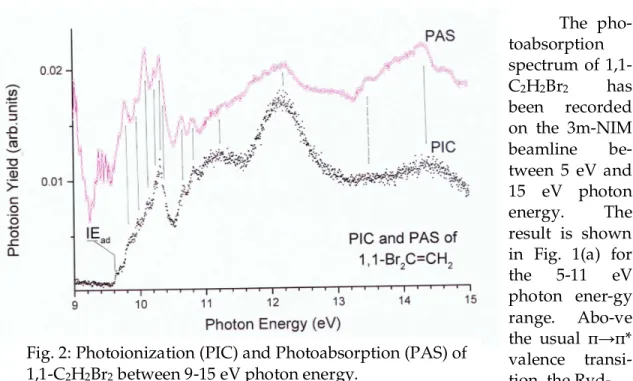THE VUV PHOTOABSORPTION SPECTROSCOPY AND PHOTOIONIZATION OF HALOGENATED ETHYLENES: BROMO-DERIVATIVES.
R. Locht1, B. Leyh1, H.W. Jochims2, H. Baumgärtel2.
1 Molecular Dynamics Laboratory, Department of Chemistry, Institute of Chemistry,
University of Liège, Sart-Tilman par B-4000 Liège 1, Belgium.
2Institut für Physikalische und Theoretische Chemie, Freie Universität Berlin,
Takustrasse 3, D-14195 Berlin, Germany.
For several years we investigate halogenated derivatives of methane and ethylene with focusing on the dynamics of highly excited states of their cations. For this purpose photoabsorption (PAS), photoelectron spectroscopies (PES, TPES and CIS), photoionization mass spectrometry (PIMS) and fragment ion translational energy (TES) spectroscopy are applied. Discharges in rare gases and synchrotron radiation are used as light sources. The VUV-PAS, PIMS, PES and TPES study of CH3X (X=F, Cl, Br) [1,2,3]
and C2H3X (X=Cl, Br) [4,5] have been reported.
Almost all disubstitu-ted derivatives of ethylene corresponding to C2H2X2,
where X=F and/or Cl, have been extensively investiga-ted by Kaufel [6] using syn-chrotron PIMS. Almost all fragment ions have been recorded and thermochem-cal data have been dedu-ced.
In the frame of the present ongoing project, the PAS, PES, TPES and CIS spectra have been reported earlier for 1,1-C2H2F2 and
the three isomers of C2H2Cl2
[7]. However, data about the disubstituted bromoethyle-nes are very scarce. To the best of our knowledge only the VUV-PAS of trans-1,2-C2H2Br2 [8] is available in
the literature. PES spectra have been reported by Wittel and Bock [9]. PIMS work on cis- and trans-Fig. 1: VUV absorption spectrum of 1,1-C2H2Br2
C2H2Br2 has been published by Momigny [10].
berg transitions start up from 7.2 eV. The detailed analysis of this part of the spectrum is in progress. Interesting is the comparison with the corresponding difluorinated compound 1,1-C2F2Br2 as displayed in Fig. 1(b) and recorded under the
same conditions. Both spectra clearly show similarities but (i) the ̟→̟* transition is stronger and blue-shifted and (ii) several peaks, e.g., at 8.2 eV, 8.8 eV and near 10 eV in C2H2Br2 are blue shifted in C2F2Br2. This has very likely to be ascribed to the
expected perfluoro-effect. It is also highly interesting to compare the PAS of these two latter compounds to those characterizing 1,1-C2H2X2 and 1,1-C2F2X2 (with X= F
and/or Cl). These VUV spectra have been measured earlier [11].
The photoionization mass spectrum of 1,1-C2H2Br2 recorded at 20 eV photon
energy essentially shows three ions, i.e., C2H2Br2+, C2H2Br+ and C2H2+. Fig. 2 displays
the photoionization efficiency curve (PIC) of C2H2Br2+ between 9.0-15.0 eV photon
energy. The PAS of 1,1-C2H2Br2 as measured in the high photon energy range is also
displayed in Fig. 2. Vertical bars highlight the close correlation between the features observed in the PIC of the molecular ion and the PAS of the neutral molecule. IEad
indicates the position of the adiabatic ionization energy IEad(1,1-C2H2Br2)=
9.612±0.010 eV. This value is lower than the PES value of 9.63 eV reported by Wittel and Bock [9]. However, these authors do not mention the error limits on their reported measurements. At higher photon energies the vibrational structure is visible but more and more embedded in the autoionization structure.
Fig. 2: Photoionization (PIC) and Photoabsorption (PAS) of 1,1-C2H2Br2 between 9-15 eV photon energy.
The pho-toabsorption spectrum of 1,1-C2H2Br2 has been recorded on the 3m-NIM beamline be-tween 5 eV and 15 eV photon energy. The result is shown in Fig. 1(a) for the 5-11 eV photon ener-gy range. Abo-ve the usual ̟→̟* valence transi-tion, the Ryd-
Acknowledgments.
The authors are indebted to the FNRS and the EU (Contract n°RII3-2004-506008) for financial support.
References.
[1]. R. Locht, B. Leyh, A. Hoxha, D. Dehareng, H.W. Jochims, H. Baumgärtel, Chem. Phys. 257 (2000) 283; R. Locht, J. Momigny, E. Rühl, H. Baumgärtel, Chem.Phys. 117 (1987) 305.
[2]. R. Locht, B. Leyh, A. Hoxha, H.W. Jochims, H. Baumgärtel, Chem. Phys. 272 (2001) 259; R. Locht, B. Leyh, A. Hoxha, D. Dehareng, K. Hottmann, H.W. Jochims, H. Baumgärtel, Chem.Phys. 272 (2001) 293.
[3]. R. Locht, B. Leyh, H.W. Jochims, H. Baumgärtel, Chem.Phys. 317 (2005) 73; R. Locht, B. Leyh, D. Dehareng, K. Hottmann, H.W. Jochims,, H. Baumgärtel, 323 (2006) 458.
[4]. R. Locht, B. Leyh K. Hottmann, H. Baumgärtel, Chem.Phys. 220 (1997) 207. [5]. A. Hoxha, R. Locht, B. Leyh, D. Dehareng, K. Hottmann, H.W. Jochims, H. Baumgärtel, 260 (2000) 237; ibid. Chem.Phys. 256 (2000) 239.
[6]. R. Kaufel, Ph.D. Dissertation, FU Berlin (1985).
[7]. R. Locht, B. Leyh, H.W. Jochims, H. Baumgärtel, BESSY Jahresbericht (1996) 156; B. Leyh, R. Locht, K. Hottmann, H. Baumgärtel, BESSY Jahresbericht (1995) 163. [8]. K. Wittel, W.S. Felps,, L. Klasinc, S.P. Glynn, J.Chem.Phys. 65 (1976) 3698. [9]. K. Wittel, H. Bock, Chem.Ber. 107 (1974) 317.
[10]. J. Momigny, Bull.Classe Sci.Acad.Roy.Belg. 46 (1960) 686.
